Mechanical Properties and Fracture Toughness Prediction of Ductile Cast Iron under Thermomechanical Treatment
Abstract
1. Introduction
2. Material Characterization
3. Experimental Work
Simple Fracture Toughness Model
4. Finite Element Modeling
5. Results and Discussion
5.1. Effect of Temperature
5.2. Effect of Strain Rate
5.3. Fracture Toughness
6. Conclusions
Author Contributions
Funding
Data Availability Statement
Acknowledgments
Conflicts of Interest
References
- Trelles, E.G.; Eckmann, S.; Schweizer, C. Experimental characterization of the short crack growth behavior of a ductile cast iron (DCI GJS-500) affected by intergranular embrittlement at temperatures nearby 400 °C. Int. J. Fatigue 2022, 155, 106573. [Google Scholar] [CrossRef]
- Fonte, M.; Infante, V.; Freitas, M.; Reis, L. Failure mode analysis of two diesel engine crankshafts. Procedia Struct. Integr. 2016, 1, 313–318. [Google Scholar] [CrossRef]
- Sertucha, J.; Suárez, R.; Izaga, J.; Hurtado, L.; Legazpi, J. Prediction of solid state structure based on eutectic and eutectoid transformation parameters in spheroidal graphite irons. Int. J. Cast Met. Res. 2006, 19, 315–322. [Google Scholar] [CrossRef]
- Asi, O. Failure of a diesel engine injector nozzle by cavitation damage. Eng. Fail. Anal. 2006, 13, 1126–1133. [Google Scholar] [CrossRef]
- Hou, X.-q.; Li, Y.; Jiang, T. Fracture failure analysis of ductile cast iron crankshaft in a vehicle engine. J. Fail. Anal. Prev. 2011, 11, 10–16. [Google Scholar] [CrossRef]
- Moore, D.; Packer, K.; Jones, A.; Carlson, D. Crankshaft failure and why it may happen again. Pract. Fail. Anal. 2001, 1, 63–72. [Google Scholar] [CrossRef]
- Mottitschka, T.; Pusch, G.; Biermann, H.; Zybell, L.; Kuna, M. Influence of graphite spherical size on fatigue behaviour and fracture toughness of ductile cast iron EN-GJS-400-18LT. Int. J. Mater. Res. 2012, 103, 87–96. [Google Scholar] [CrossRef]
- de La Torre, U.; Lacaze, J.; Sertucha, J. Chunky graphite formation in ductile cast irons: Effect of silicon, carbon and rare earths. Int. J. Mater. Res. 2016, 107, 1041–1050. [Google Scholar] [CrossRef]
- Kasvayee, K.A. Microstructure and Deformation Behaviour of Ductile Iron under Tensile Loading. Ph.D. Thesis, School of Engineering, Jönköping University, Jönköping, Sweden, 2015. [Google Scholar]
- Dong, M.; Prioul, C.; François, D. Damage effect on the fracture toughness of nodular cast iron: Part I. Damage characterization and plastic flow stress modeling. Metall. Mater. Trans. A 1997, 28, 2245–2254. [Google Scholar] [CrossRef]
- Xiang, S.; Jonsson, S.; Babu, R.P.; Zhu, B.; Odqvist, J. Influence of tension and compression dwell on the creep-fatigue properties of the austenitic cast iron Ni-resist D5S. Mater. Sci. Eng. A 2021, 814, 141179. [Google Scholar] [CrossRef]
- Öberg, C.; Zhu, B.; Jonsson, S. Creep behaviour, creep damage and precipitation in the austenitic ductile cast iron D5S at 750 °C. Mater. Sci. Eng. A 2021, 802, 140662. [Google Scholar] [CrossRef]
- Öberg, C. Creep Behavior of High Temperature Cast Materials for Exhaust Applications. Ph.D. Thesis, KTH Royal Institute of Technology, Stockholm, Sweden, 2020. [Google Scholar]
- de la Torre, U.; González-Martínez, R.; Méndez, S. Effect of the section size, holding temperature and time on the kinetics of the ausferritic transformation and mechanical properties of as-cast ausferritic ductile iron. Mater. Sci. Eng. A 2020, 788, 139536. [Google Scholar] [CrossRef]
- Angella, G.; Taloni, M.; Donnini, R.; Zanardi, F. The Correlation between Solidification Rates, Microstructure Integrity and Tensile Plastic Behaviour in 4.2 wt.% Silicon Strengthened Ductile Iron. J. Cast. Mater. Eng. 2022, 6, 1–8. [Google Scholar] [CrossRef]
- Pacha-Gołębiowska, H.; Piekarska, W. Mechanical properties of ductile cast iron relation to the charge elements. Proc. IOP Conf. Ser. Mater. Sci. Eng. 2021, 1199, 012022. [Google Scholar] [CrossRef]
- Wu, X.; Quan, G.; MacNeil, R.; Zhang, Z.; Sloss, C. Failure mechanisms and damage model of ductile cast iron under low-cycle fatigue conditions. Metall. Mater. Trans. A 2014, 45, 5085–5097. [Google Scholar] [CrossRef]
- Bendikiene, R.; Ciuplys, A.; Cesnavicius, R.; Jutas, A.; Bahdanovich, A.; Marmysh, D.; Nasan, A.; Shemet, L.; Sherbakov, S. Influence of Austempering Temperatures on the Microstructure and Mechanical Properties of Austempered Ductile Cast Iron. Metals 2021, 11, 967. [Google Scholar] [CrossRef]
- Kobayashi, T.; Yamada, S. Evaluation of static and dynamic fracture toughness in ductile cast iron. Metall. Mater. Trans. A 1994, 25, 2427–2436. [Google Scholar] [CrossRef]
- Artola, G.; Monzón, A.; Lacaze, J.; Sertucha, J. Tensile properties and fracture toughness at service temperatures of an optimized pearlitic ductile iron alloy for automotive crankshafts. Mater. Sci. Eng. A 2022, 831, 142206. [Google Scholar] [CrossRef]
- Boulifa, I.; Hadji, A. Study of the influence of alloying elements on the mechanical characteristics and wear behavior of a ductile cast iron. Frat. Ed Integrità Strutt. 2021, 15, 74–83. [Google Scholar] [CrossRef]
- Eric, O.; Sidjanin, L.; Miskovic, Z.; Zec, S.; Jovanovic, M. Microstructure and toughness of CuNiMo austempered ductile iron. Mater. Lett. 2004, 58, 2707–2711. [Google Scholar] [CrossRef]
- Putatunda, S.K. Influence of austempering temperature on fracture toughness of a low manganese Austempered Ductile Iron (ADI). Mater. Manuf. Process. 2001, 16, 245–263. [Google Scholar] [CrossRef]
- Putatunda, S.K. Development of austempered ductile cast iron (ADI) with simultaneous high yield strength and fracture toughness by a novel two-step austempering process. Mater. Sci. Eng. A 2001, 315, 70–80. [Google Scholar] [CrossRef]
- Sckudlarek, W.; Krmasha, M.N.; Al-Rubaie, K.S.; Preti, O.; Milan, J.C.; da Costa, C.E. Effect of austempering temperature on microstructure and mechanical properties of ductile cast iron modified by niobium. J. Mater. Res. Technol. 2021, 12, 2414–2425. [Google Scholar] [CrossRef]
- Laine, J.; Jalava, K.; Vaara, J.; Soivio, K.; Frondelius, T.; Orkas, J. The mechanical properties of ductile iron at intermediate temperatures: The effect of silicon content and pearlite fraction. Int. J. Met. 2021, 15, 538–547. [Google Scholar] [CrossRef]
- Wang, Y.; Zhang, Y.; Song, R.; Huang, L.; Pei, Y. Effect of the austenitizing temperature on microstructure evolution and impact toughness of a novel bainite ductile iron. Met. Mater. Int. 2021, 27, 4014–4022. [Google Scholar] [CrossRef]
- Abdellah, M.Y.; Fadhl, B.M.; Abu El-Ainin, H.; Hassan, M.K.; Backar, A.H.; Mohamed, A.F. Experimental Evaluation of Mechanical and Tribological Properties of Segregated Al-Mg-Si Alloy Filled with Alumina and Silicon Carbide through Different Types of Casting Molds. Metals 2023, 13, 316. [Google Scholar] [CrossRef]
- Berdin, C.; Haušild, P. Damage Mechanisms and Local Approach to Fracture: Part I: Ductile fracture. In Transferability of Fracture Mechanical Characteristics; Springer: Dordrecht, The Netherlands, 2002; pp. 167–180. [Google Scholar]
- Berdin, C.; Dong, M.; Prioul, C. Local approach of damage and fracture toughness for nodular cast iron. Eng. Fract. Mech. 2001, 68, 1107–1117. [Google Scholar] [CrossRef]
- Jing, Z. Prediction of failure of cast iron with dynamic loading and high temperature. Mater. Sci. Eng. A 2013, 566, 71–81. [Google Scholar] [CrossRef]
- Joshi, A.; Baxevanakis, K.P.; Silberschmidt, V.V. High-temperature creep of cast irons. In Solid Mechanics, Theory of Elasticity and Creep; Springer: Berlin/Heidelberg, Germany, 2023; pp. 147–173. [Google Scholar]
- Basurto-Hurtado, J.A.; Perez-Soto, G.; Osornio-Rios, R.A.; Dominguez-Gonzalez, A.; Morales-Hernandez, L. A new approach to modeling the ductile cast iron microstructure for a finite element analysis. Arab. J. Sci. Eng. 2019, 44, 1221–1231. [Google Scholar] [CrossRef]
- Abdellah, M.Y.; Hassan, M.K.; El-Ainin, H.A. Plasticity and formability controlling of cast iron using thermo-mechanical treatment. Am. J. Mater. Eng. Technol. 2014, 2, 38–42. [Google Scholar]
- ASTM E8; Standard Test Methods for Tension Testing of Metallic Materials. Annual Book of ASTM Standards. ASTM: West Conshohocken, PA, USA, 2001.
- Anderson, T.L. Fracture Mechanics: Fundamentals and Applications; CRC Press: Boca Raton, FL, USA, 2017. [Google Scholar]
- Srinivasan, M.; Seetharamu, S. Fracture toughness of metal castings. In Science and Technology of Casting Processes; IntechOpen: London, UK, 2012. [Google Scholar]
- Systèmes, D. Fracture Mechanics Study of a Compact Tension Specimen Using Abaqus/CAE; Abaqus Technology Brief; Abaqus: Johnston, RI, USA, 2007; pp. 1–7. [Google Scholar]
- ASTM E1737; Standard Test Method for J-Integral Characterization of Fracture Toughness. Annual Book of ASTM Standards. ASTM: West Conshohocken, PA, USA, 1996.
- Robinson, J.; Tetelman, A. The relationship between crack tip opening displacement, local strain and specimen geometry. Int. J. Fract. 1975, 11, 453–468. [Google Scholar] [CrossRef]
- Wells, A. Application of fracture mechanics at and beyond general yielding. Br. Weld. J. 1963, 10. [Google Scholar]
- Hahn, G.T.; Rosenfield, A.R. Local yielding and extension of a crack under plane stress. Acta Metall. 1965, 13, 293–306. [Google Scholar] [CrossRef]
- Hahn, G.; Rosenfield, A. Sources of fracture toughness: The relation between K Ic and the ordinary tensile properties of metals. In Applications Related Phenomena in Titanium Alloys; ASTM International: West Conshohocken, PA, USA, 1968. [Google Scholar]
- Abdellah, M.Y.; Alsoufi, M.S.; Hassan, M.K.; Ghulman, H.A.; Mohamed, A.F. Extended finite element numerical analysis of scale effect in notched glass fiber reinforced epoxy composite. Arch. Mech. Eng. 2015, 62, 217–236. [Google Scholar] [CrossRef]
- Abdellah, M.Y. Comparative Study on Prediction of Fracture Toughness of CFRP Laminates from Size Effect Law of Open Hole Specimen Using Cohesive Zone Model. Eng. Fract. Mech. 2018, 191, 277–285. [Google Scholar] [CrossRef]
- Abdellah, M.Y.; Sadek, M.G.; Alharthi, H.; Abdel-Jaber, G. Mechanical, thermal, and acoustic properties of natural fibre-reinforced polyester. Proc. Inst. Mech. Eng. Part E J. Process Mech. Eng. 2023, 09544089231157638. [Google Scholar] [CrossRef]
- Mohammed, Y.; Hassan, M.K.; Hashem, A. Finite element computational approach of fracture toughness in composite compact tension specimen. Int. J. Mech. Mechatron. Eng. 2012, 12, 57–61. [Google Scholar]
- Nishi, S.; Kobayashi, T.; Taga, S.; Kurosawa, S. Fragilisation par Revenu de la Fonte a Graphite Spheroidal. Ph.D. Thesis, Université de Lille, Lille, France, 1976. [Google Scholar]
- Kobayashi, T. Ductile cast iron. In Strength and Toughness of Materials; Springer: Berlin/Heidelberg, Germany, 2004; pp. 89–110. [Google Scholar]
- Den Uijl, N.; Carless, L. Advanced metal-forming technologies for automotive applications. In Advanced Materials in Automotive Engineering; Elsevier: Amsterdam, The Netherlands, 2012; pp. 28–56. [Google Scholar]
- Levy, B.; Van Tyne, C. Effect of a strain-hardening rate at uniform elongation on sheared edge stretching. J. Mater. Eng. Perform. 2012, 21, 2147–2154. [Google Scholar] [CrossRef]
- Kogoh, S.; Sakai, T.; Asami, K. Temperature dependence of tensile strength and hardness for nodular cast iron and their mutual correlation. J. Mater. Sci. 1992, 27, 4323–4328. [Google Scholar] [CrossRef]
- Wood, D.; Clark, D. The influence of temperature upon the time delay for yielding in annealed mild steel. Trans. Am. Soc. Met. 1951, 43, 571–586. [Google Scholar]
- Konovalenko, I.; Maruschak, P.; Prentkovskis, O. Automated method for fractographic analysis of shape and size of dimples on fracture surface of high-strength titanium alloys. Metals 2018, 8, 161. [Google Scholar] [CrossRef]
- Haitao, X.; Dengke, W.; Kaihong, S. Effect of deformation temperature on mechanical properties and microstructure of TWIP steel for expansion tube. High Temp. Mater. Process. 2020, 39, 63–73. [Google Scholar] [CrossRef]
- Dieter, G.E.; Bacon, D.J. Mechanical Metallurgy; McGraw-Hill: New York, NY, USA, 1976; Volume 3. [Google Scholar]
- Ma, L.; Daemen, J. Strain rate dependent strength and stress–strain characteristics of a welded tuff. Bull. Eng. Geol. Environ. 2006, 65, 221–230. [Google Scholar] [CrossRef]
- Yin, B.; Steinke, C.; Kaliske, M. Formulation and implementation of strain rate-dependent fracture toughness in context of the phase-field method. Int. J. Numer. Methods Eng. 2020, 121, 233–255. [Google Scholar] [CrossRef]
- Pariente, I.; Belzunce, F.; Riba, C.y.J. Mechanical strength and fracture toughness of high chromium white cast irons. Mater. Sci. Technol. 2008, 24, 981–985. [Google Scholar] [CrossRef]
- Salzbrenner, R.; Van Den Avyle, J.A.; Lutz, T.J.; Bradley, W.L. Fracture Toughness Testing of Ductile Cast Irons. In Fracture Mechanics: Sixteenth Symposium; ASTM International: West Conshohocken, PA, USA, 1985. [Google Scholar]

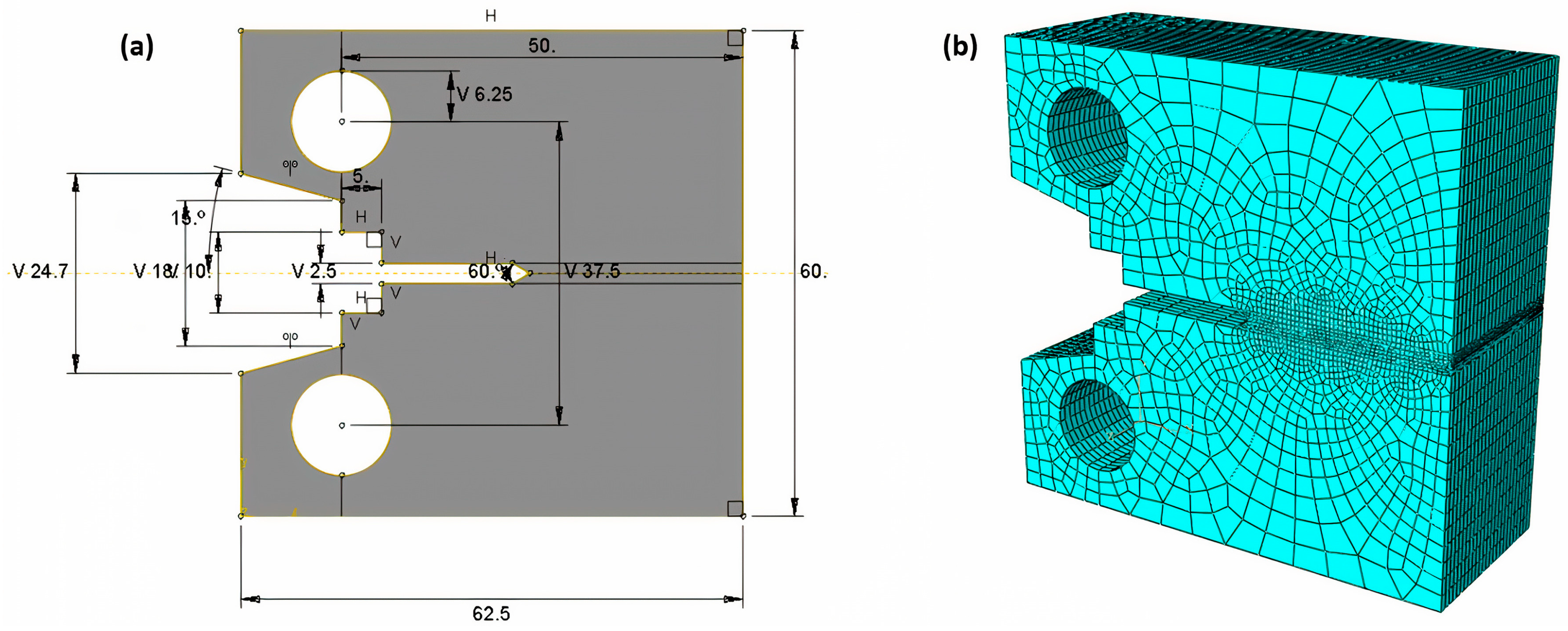

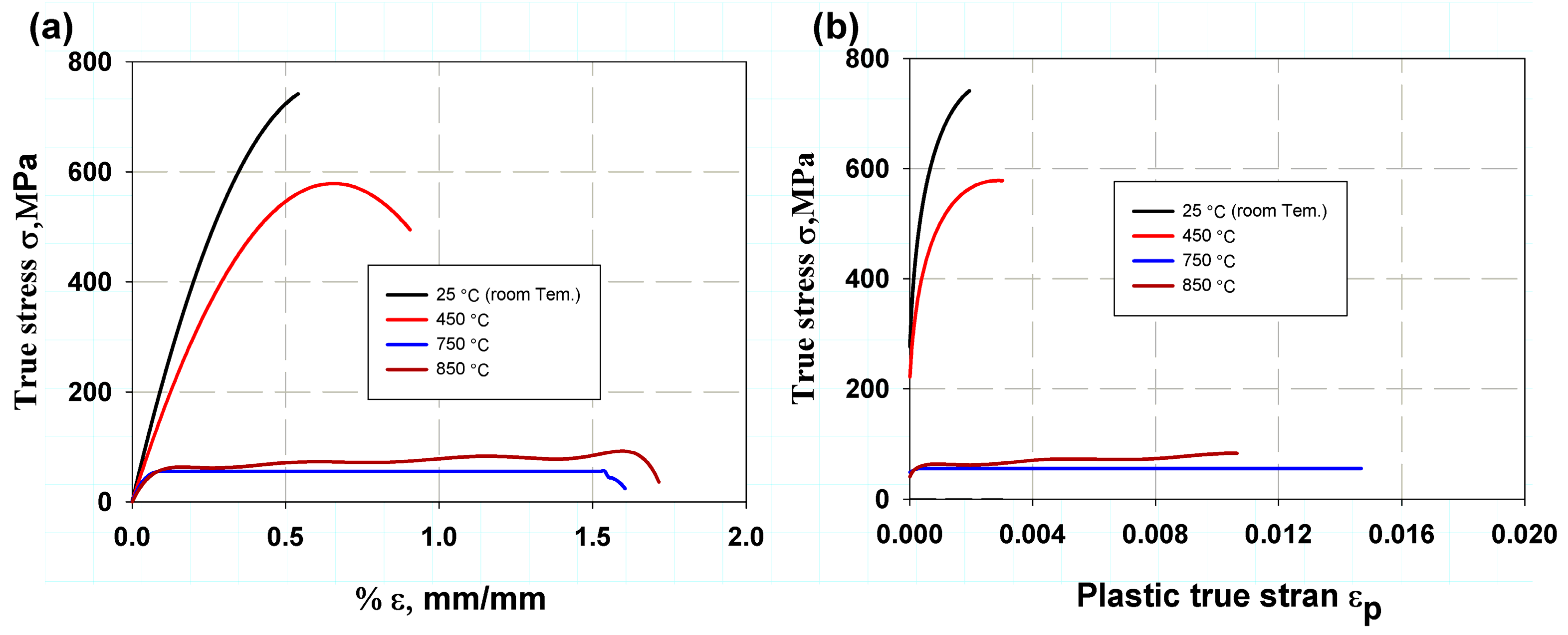
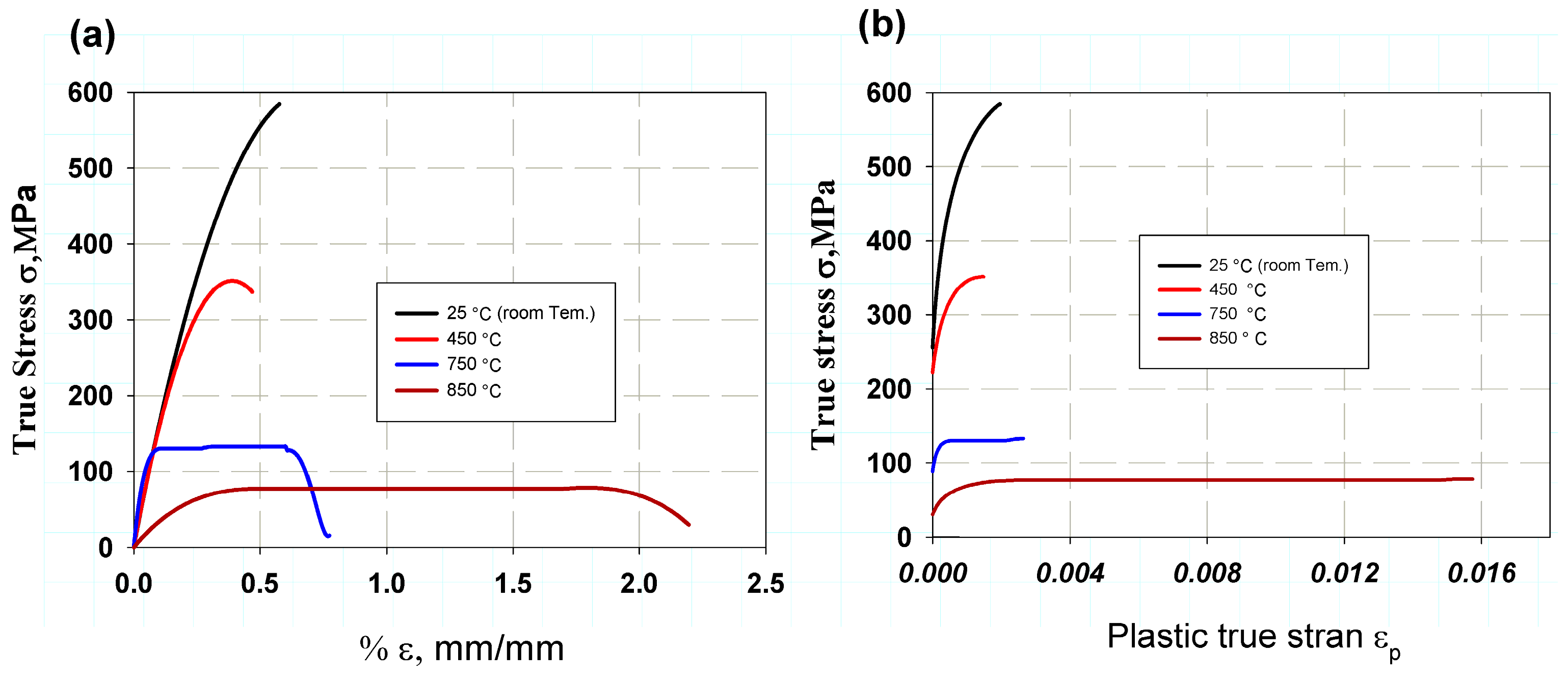

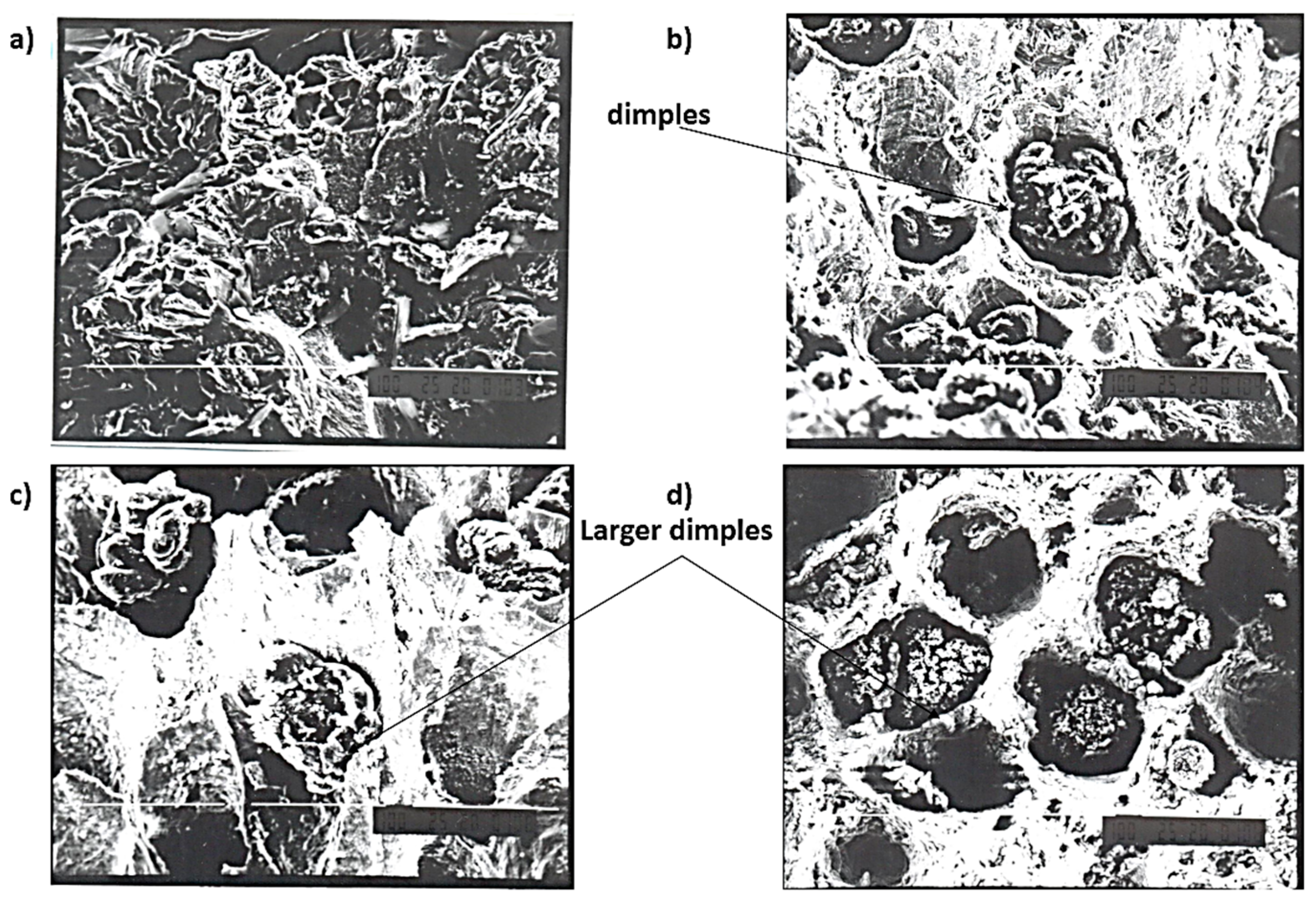

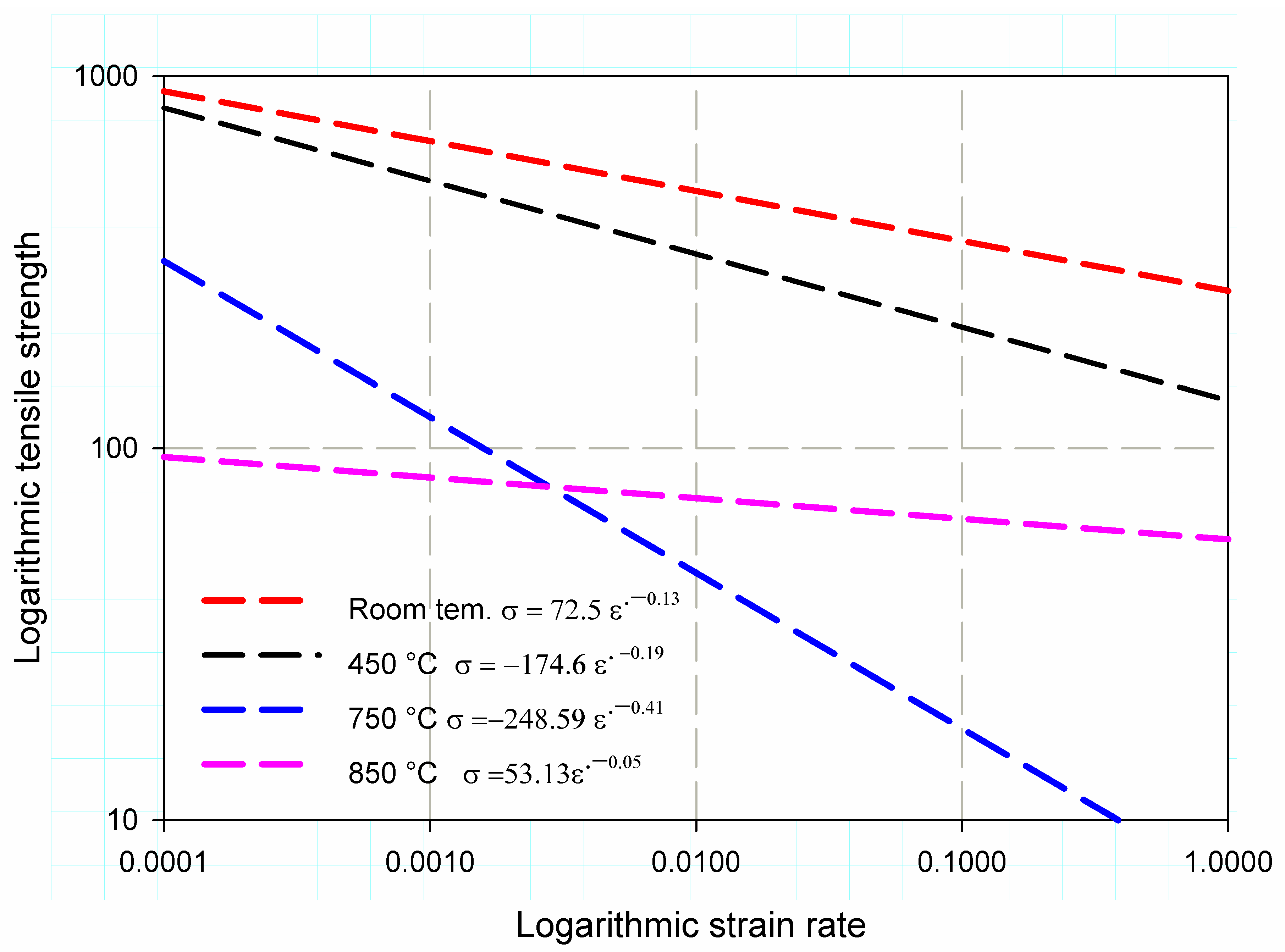
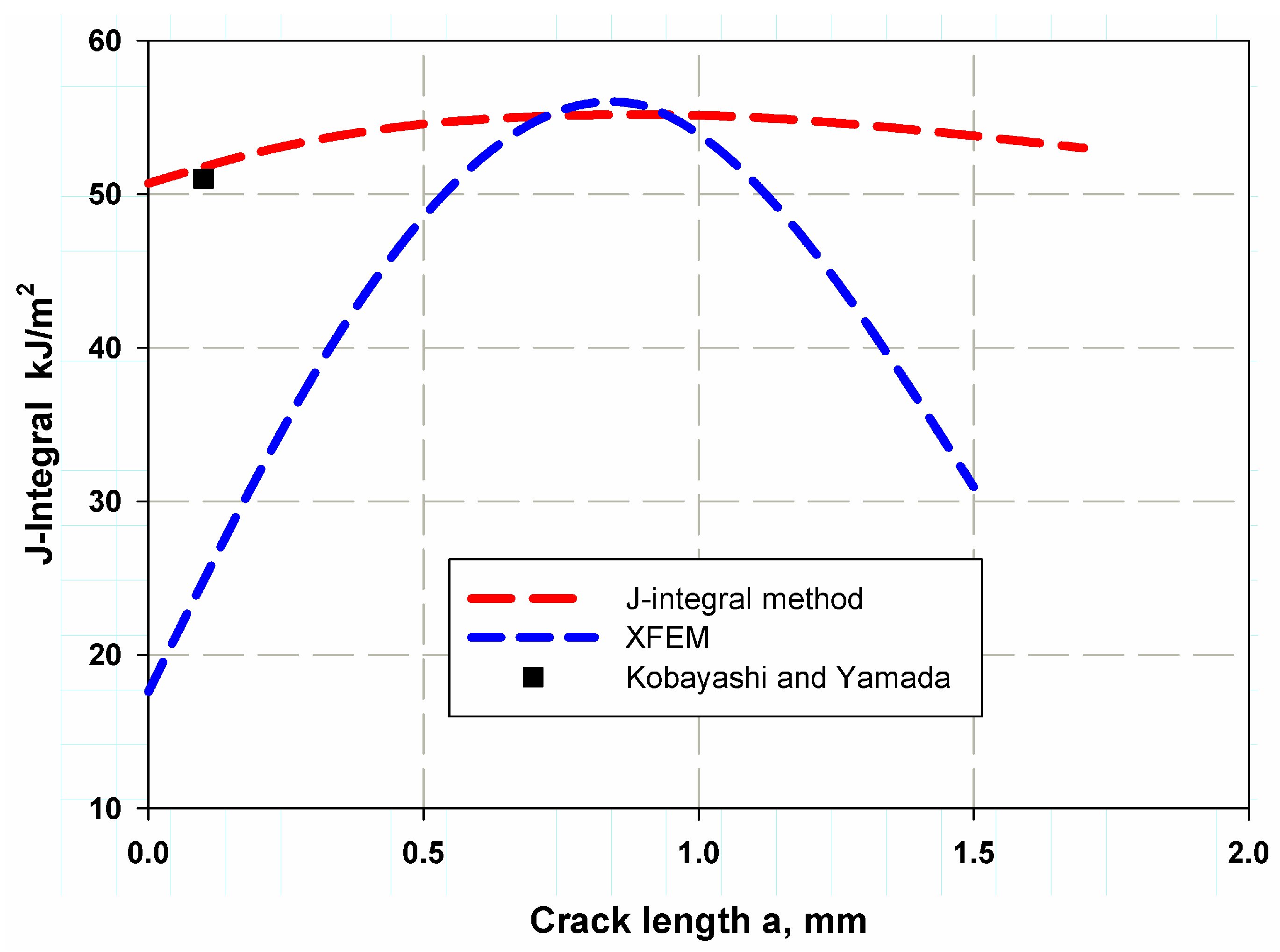
| Element | C% | Si% | Mn% | P% | S% | Balanced Fe |
| Contents (mg) | 3.0–3.6 | 2.0–2.5 | 0.6 | 0.04 max | 0.04 |
| Properties | Temp. | 25 °C | 450 °C | 750 °C | 850 °C |
|---|---|---|---|---|---|
| Young modulus E, GPa | 169.3 | 183.7 | 95.5 | 90.67 | |
| Ultimate strength σu, MPa | 806 | 710 | 244.82 | 87.4 | |
| Yield stress σy, MPa | 611 | 450 | 156 | 21.27 | |
| Fracture strain % εf | 0.59 | 0.65 | 1 | 0.95 | |
| Yield strain 0.2% ε | 0.36 | 0.25 | 0.15 | 0.05 | |
| Stiffness stress K | 1412 | 1445 | 575 | 575 | |
| Strain hardening coefficient n | 0.08 | 0.123 | 0.13 | 0.36 | |
| Properties | Temp. | 25 °C | 450 °C | 750 °C | 850 °C |
|---|---|---|---|---|---|
| Young modulus E, GPa | 34.6 | 29.35 | 24.43 | 17.42 | |
| Ultimate strength σu, MPa | 737.6 | 565 | 130 | 92 | |
| Yield stress σy, MPa | 474.1 | 442 | 46 | 61.36 | |
| Fracture strain % εf | 0.55 | 0.91 | 1.5 | 1.7 | |
| Yield strain 0.2% ε | 0.25 | 0.32 | 0.035 | 0.073 | |
| Stiffness stress K | 1479 | 912 | 154 | 107 | |
| Strain hardening coefficient n | 0.11 | 0.08 | 0.11 | 0.1 | |
| Properties | Temp. | 25 °C | 450 °C | 750 °C | 850 °C |
|---|---|---|---|---|---|
| Young modulus E, GPa | 29.34 | 15.97 | 13.18 | 0.903 | |
| Ultimate strength σu, MPa | 523 | 377 | 63.06 | 73.14 | |
| Yield stress σy, MPa | 283 | 207 | 113 | 63 | |
| Fracture strain εf | 0.59 | 0.49 | 0.69 | 2.2 | |
| Yield strain 0.2% ε | 0.21 | 0.16 | 0.054 | 0.16 | |
| Stiffness stress K | 2951 | 1258 | 199 | 114 | |
| Strain hardening coefficient n | 0.23 | 0.18 | 0.069 | 0.079 | |
| Temperature | Strain Rate | ||
|---|---|---|---|
| 25 °C | 29.63 | 14.85 | |
| 450 °C | 35.36 | 8.28 | |
| 750 °C | 0.24 | 1.52 | |
| 850 °C | 1.15 | 2.52 | |
Disclaimer/Publisher’s Note: The statements, opinions and data contained in all publications are solely those of the individual author(s) and contributor(s) and not of MDPI and/or the editor(s). MDPI and/or the editor(s) disclaim responsibility for any injury to people or property resulting from any ideas, methods, instructions or products referred to in the content. |
© 2024 by the authors. Licensee MDPI, Basel, Switzerland. This article is an open access article distributed under the terms and conditions of the Creative Commons Attribution (CC BY) license (https://creativecommons.org/licenses/by/4.0/).
Share and Cite
Abdellah, M.Y.; Alharthi, H.; Alfattani, R.; Suker, D.K.; Abu El-Ainin, H.M.; Mohamed, A.F.; Hassan, M.K.; Backar, A.H. Mechanical Properties and Fracture Toughness Prediction of Ductile Cast Iron under Thermomechanical Treatment. Metals 2024, 14, 352. https://doi.org/10.3390/met14030352
Abdellah MY, Alharthi H, Alfattani R, Suker DK, Abu El-Ainin HM, Mohamed AF, Hassan MK, Backar AH. Mechanical Properties and Fracture Toughness Prediction of Ductile Cast Iron under Thermomechanical Treatment. Metals. 2024; 14(3):352. https://doi.org/10.3390/met14030352
Chicago/Turabian StyleAbdellah, Mohammed Y., Hamzah Alharthi, Rami Alfattani, Dhia K. Suker, H. M. Abu El-Ainin, Ahmed F. Mohamed, Mohamed K. Hassan, and Ahmed H. Backar. 2024. "Mechanical Properties and Fracture Toughness Prediction of Ductile Cast Iron under Thermomechanical Treatment" Metals 14, no. 3: 352. https://doi.org/10.3390/met14030352
APA StyleAbdellah, M. Y., Alharthi, H., Alfattani, R., Suker, D. K., Abu El-Ainin, H. M., Mohamed, A. F., Hassan, M. K., & Backar, A. H. (2024). Mechanical Properties and Fracture Toughness Prediction of Ductile Cast Iron under Thermomechanical Treatment. Metals, 14(3), 352. https://doi.org/10.3390/met14030352






